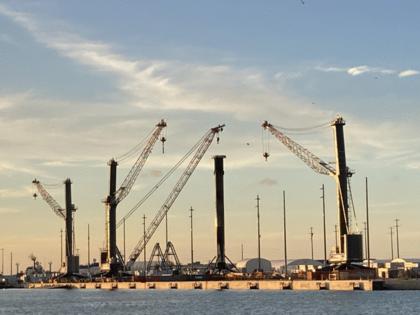Port Canaveral preps for more rocket recoveries with 3rd crane
Published in News & Features
ORLANDO, Fla. – Port Canaveral has had such a busy year supporting SpaceX’s rocket recovery efforts, it brought in a new crane to assist in the launch parade on the Space Coast.
Port CEO Capt. John Murray said the third mobile harbor crane operated by the port arrived on Aug. 3.
“We had this crane modified somewhat to accommodate Relativity Space’s rocket that they may be modifying and it may not work as we originally intended.” he said. “They may have a different booster now.”
Murray did note that all of the port’s cranes, two of which top 320 feet tall, had been modified for the space industry.
“We did that with the very first one,” he said. “Major modification is the elevation of the mast. If you don’t have enough range to lift up at a high point, then you can’t move a booster off a recovery vehicle. So we did that with the first crane, and we’ve kept that in place.”
The third crane has modified counterweights that would allow the lift of a taller, heavier booster, which would have worked for Relativity’s Terran R based off earlier specifications, but those have since changed, according to port officials.
The Sentinel reached out to Relativity Space to see what their plans would be without the use of the port’s harbor cranes. The company could potentially seek help getting offloaded from another launch provider, Blue Origin, which owns a fourth crane at the site brought in to handle its massive New Glenn booster recoveries when they begin returning to port.
For now, the port’s primary use of its three cranes among space companies has been for Elon Musk’s SpaceX, which has used them for Falcon 9 boosters caught on the company’s pair of drone ships that come in from the Atlantic after launches. The cranes still have plenty of work for heavy cargo other than rocket boosters, though.
For Port Canaveral, it has been a growing segment of its cargo operations, although cruise traffic remains its meat and potatoes.
Murray said that through 11 months of the port’s 2025 fiscal year, covering October 2024 through August 2025, Port Canaveral had recovered 81 boosters and 176 fairings.
A Space Florida-commissioned report about expanding the dedicated space needed for maritime support of the space industry at the port noted SpaceX pays about $61,000 per booster recovery operation, but in 2024, that all aerospace support amounted to less than 1% of the port’s revenue.
The genesis of the report was an expected increase in maritime support needs as Blue Origin, Relativity Space and other companies like Stoke Space began to increase the frequency of their launches, many of which would rely on downrange recovery vessels that then use port facilities to get their hardware back for refurbishment.
SpaceX earlier this month received the OK from the Federal Aviation Administration to increase from 50 to 120 the number of Falcon 9 launches from its Cape Canaveral pad while also seeking to increase Falcon 9 launches from 20 to 36 from Kennedy Space Center. Combined that could add up to 102 booster landings in the Atlantic with the other 54 targeted land recoveries at pads back at the launch sites.
Relativity Space has only flown its smaller Terran 1 rocket from Cape Canaveral once back in 2023. Its new larger Terran R rocket, though, is designed to allow for booster recovery. The Space Force has approved Relativity for as many as 24 launches a year.
Blue Origin’s privately owned crane at the port stands at 375 feet tall, making it the tallest point in Port Canaveral, but has yet to be used for operational rocket booster recovery.
That could change as soon as this month, though, as Jeff Bezos’ company lines up its second ever launch of the New Glenn rocket. The company was not able to nail the booster landing on its first try, so the recovery vessel, named Jacklyn in honor of Bezos’ mother, has yet to catch its first booster.
For now the Space Force has approved Blue Origin for 12 launches a year.
The Space Florida report estimated launch and recovery missions from all providers would top 200 from the Space Coast by 2028 and could expand to as many as 1,250 missions within the next five decades.
-------------
©2025 Orlando Sentinel. Visit at orlandosentinel.com. Distributed by Tribune Content Agency, LLC.







Comments